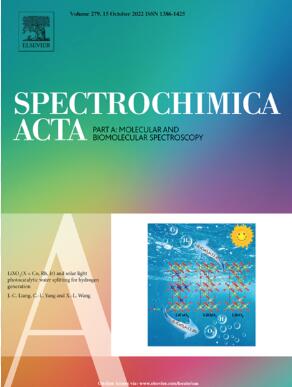Visible wavelength interrogation of Kretschmann based SPR spectroscopy using polymeric ZnO quantum Dot layer for chloride detection
IF 4.6
2区 化学
Q1 SPECTROSCOPY
Spectrochimica Acta Part A: Molecular and Biomolecular Spectroscopy
Pub Date : 2025-02-12
DOI:10.1016/j.saa.2025.125872
引用次数: 0
Abstract
Applying visible-wavelength interrogation Kretschmann SPR spectroscopy technique using a polymeric ZnO-Quantum Dot PVA (pZnOQD) layer for chloride ion detection represents a significant advancement in photonic technology. This method streamlines the detection process while maintaining high sensitivity. Molecular analysis reveals subtle shifts in specific peaks of the ZnOQD spectrum after the interaction, suggesting chloride ion interaction with the active layer. Subsequent SPR analysis confirms these findings, showing wavelength shifts in SPR peaks between 630 – 660 nm across different chloride ion concentrations. This technique demonstrates exceptional sensitivity, detecting chloride ion concentrations from 1.0 to 20.0 ppm, with two distinct sensitivity ranges (1.0 – 4.0 ppm and 4.0 – 20.0 ppm) and corresponding values of 1.7221 (R2 = 0.998) and 0.627 nm/ppm (R2 = 0.992), respectively. These results are comparable, with a low detection limit of 0.3 ppm. Experimental data fitting well with the Sips model yields an R2 value of 0.995 and a binding affinity of 3.876 × 102M−1, providing valuable insights for sensor development. This integrated analysis provides a comprehensive understanding of chloride ion interactions with the pZnOQD sensing layer, paving the way for advanced optical spectroscopy using quantum dots.

基于聚合物ZnO量子点层的克雷奇曼SPR光谱的可见波长询问用于氯化物检测
利用聚合物zno -量子点PVA (pZnOQD)层的可见波长探测Kretschmann SPR光谱技术检测氯离子是光子技术的重大进步。该方法在保持高灵敏度的同时简化了检测过程。分子分析表明,相互作用后,ZnOQD光谱的特定峰发生了微妙的变化,表明氯离子与活性层发生了相互作用。随后的SPR分析证实了这些发现,表明在不同氯离子浓度下,SPR峰的波长在630 - 660 nm之间发生变化。该技术具有极高的灵敏度,可检测1.0 ~ 20.0 ppm的氯离子浓度,灵敏度范围为1.0 ~ 4.0 ppm和4.0 ~ 20.0 ppm,对应值分别为1.7221 nm/ppm (R2 = 0.998)和0.627 nm/ppm (R2 = 0.992)。这些结果具有可比性,检测限低至0.3 ppm。实验数据与Sips模型拟合良好,R2值为0.995,结合亲和力为3.876 × 102M−1,为传感器的开发提供了有价值的见解。这种集成分析提供了氯离子与pZnOQD传感层相互作用的全面理解,为使用量子点的先进光学光谱铺平了道路。
本文章由计算机程序翻译,如有差异,请以英文原文为准。
求助全文
约1分钟内获得全文
求助全文
来源期刊
CiteScore
8.40
自引率
11.40%
发文量
1364
审稿时长
40 days
期刊介绍:
Spectrochimica Acta, Part A: Molecular and Biomolecular Spectroscopy (SAA) is an interdisciplinary journal which spans from basic to applied aspects of optical spectroscopy in chemistry, medicine, biology, and materials science.
The journal publishes original scientific papers that feature high-quality spectroscopic data and analysis. From the broad range of optical spectroscopies, the emphasis is on electronic, vibrational or rotational spectra of molecules, rather than on spectroscopy based on magnetic moments.
Criteria for publication in SAA are novelty, uniqueness, and outstanding quality. Routine applications of spectroscopic techniques and computational methods are not appropriate.
Topics of particular interest of Spectrochimica Acta Part A include, but are not limited to:
Spectroscopy and dynamics of bioanalytical, biomedical, environmental, and atmospheric sciences,
Novel experimental techniques or instrumentation for molecular spectroscopy,
Novel theoretical and computational methods,
Novel applications in photochemistry and photobiology,
Novel interpretational approaches as well as advances in data analysis based on electronic or vibrational spectroscopy.

 求助内容:
求助内容: 应助结果提醒方式:
应助结果提醒方式:


